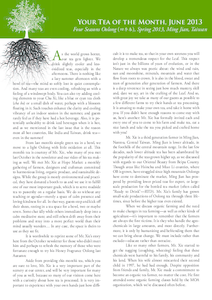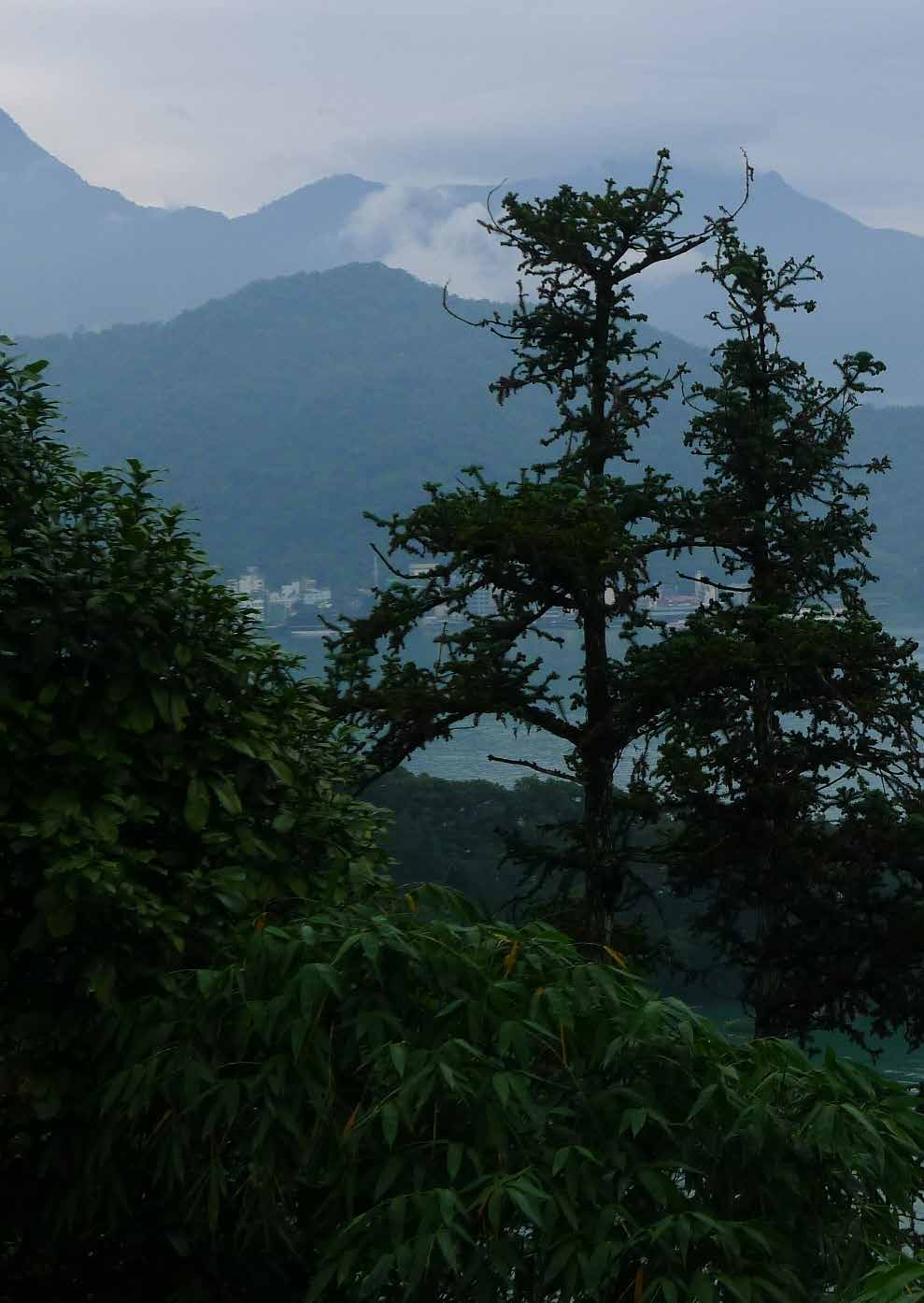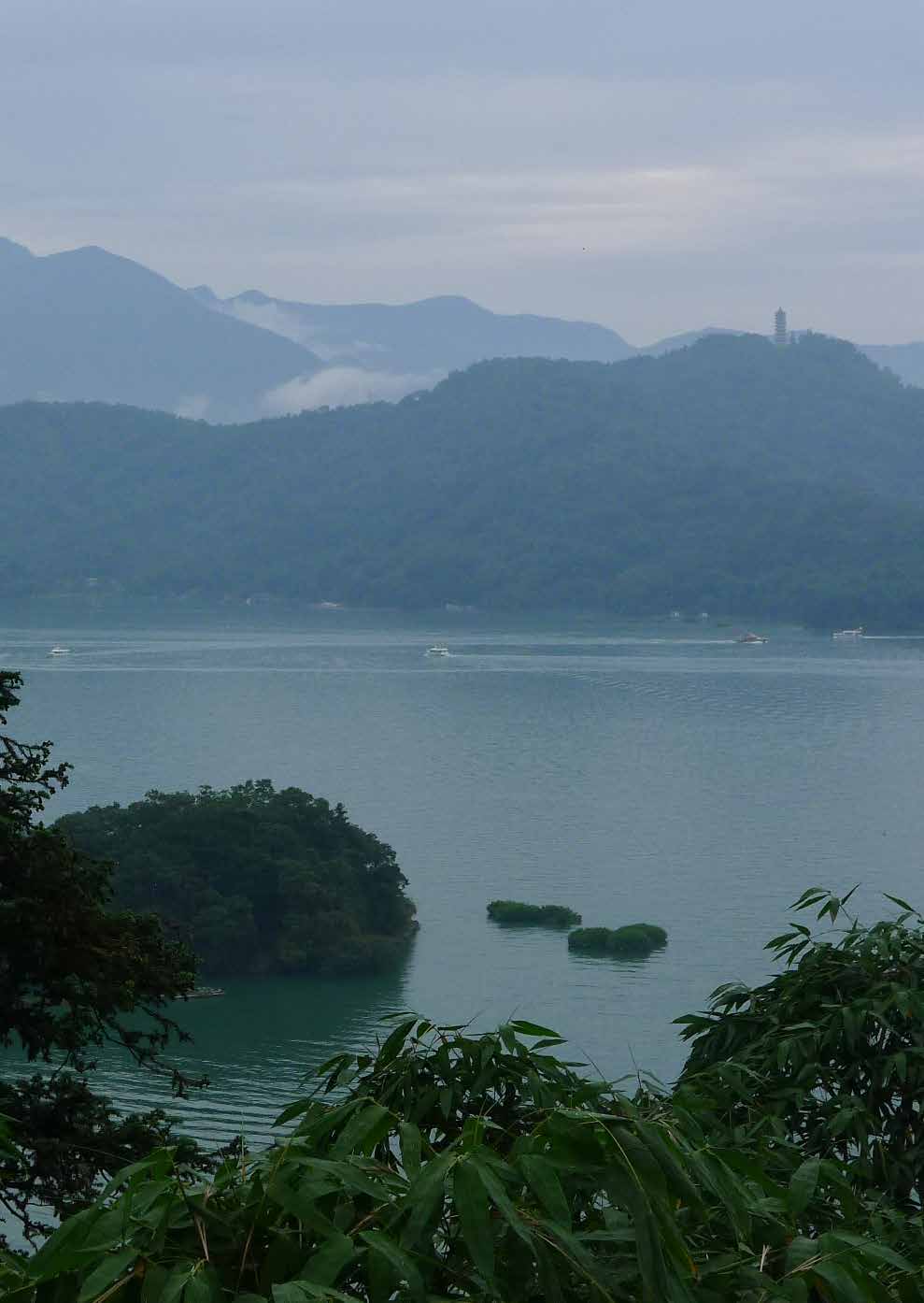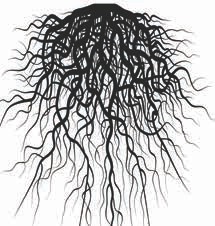
 |
|
As the world grows hotter, our tea gets lighter. We drink slightly cooler and lessoxidized teas, especially in the afternoons. There is nothing like a lazy summer afternoon with a bowl of tea - the mind so softly lost in quiet contemplation. And many teas are even cooling, refreshing us with a feeling of a windswept body. You can also try adding cooling elements to your Cha Xi, like a blue or cyan tea cloth (cha bu) or a small dish of water, perhaps with a blossom floating in it. Such touches enhance the clarity and cooling vibrancy of an indoor session in the summer, and guests rarely feel as if they have had a hot beverage. Also, it is potentially unhealthy to drink iced beverages when it is hot, and as we mentioned in the last issue that is the reason most all hot countries, like India and Taiwan, drink tea - even in the summer!

From last month's simple green tea in a bowl, we move to a light Oolong with little oxidation at all. This month's tea is courtesy of Mr. Xie, who many of you met last October in the newsletter and our video of his tea making as well. We met Mr. Xie at Hope Market: a monthly gathering of farmers, designers and craftsman committed to harmonious living, organic produce, and sustainable designs. While the group is mostly environmental and practical, they have donated a booth to us and we use it to fulfill one of our most important goals, which is to serve roadside tea to passersby on a regular basis. We do so without any teaching or agenda - merely a space of calm presence and loving-kindness for all. In that way, guests stop and kick off their shoes, resting in a tea space for a bowl, two or maybe seven. Some chat idly while others immediately drop into a calm meditative state; and still others drift away from their problems and stray into a more perfect world than their mind usually wanders... In any case, the space is theirs to use as they see fit.
It is worthwhile to reprint some of Mr. Xie's story here from the October newsletter for those who didn't meet him and perhaps to refresh the memory of those who were fortunate enough to try his Honey Fragrance Oolong last Autumn:
Aside from providing this month's tea, which you are sure to love, Mr. Xie is a very important part of the scenery at our center, and will be very important for many of you as well, because so many of our visitors come here with a curiosity about how tea is processed. It is very important to experience with your own hands just how difficult it is to make tea, so that in your own soreness you will develop a tremendous respect for the Leaf. This respect isn't just in the billions of years of evolution, or in the Nature we always wax poetic about: the wind and rain, sun and moonshine, minerals, mountain and water that flow from roots to crown. It is also in the blood, sweat and tears of generation after generation of farmers. And there is a deep reverence in seeing just how much mastery, skill and, dare we say, art in the crafting of the Leaf. And so, with great joy we take as many of our guests as possible to a few different farms to try their hands at tea processing. It is amazing to make your own tea, and take it home with you. If you didn't have enough reasons to come stay with us, here's another: Mr. Xie has formally invited each and every one of you to come to his farm and make tea, eat a nice lunch and take the tea you picked and crafted home with you!
Mr. Xie is a third generation farmer in Ming Jian, Nantou, Central Taiwan. Ming Jian is lower altitude, in the foothills of the central mountain range. In the last few decades, such lower altitude tea has been adumbrated by the popularity of the teas grown higher up, as we discussed with regards to our Oriental Beauty from Beipu County. Though areas like Hsinchu and Miao Li counties, where OB is grown, have struggled since high mountain Oolongs have come to dominate the market, Ming Jian has prospered by providing lower priced teas for export, or largescale production for the bottled tea market (often called "Ready to Drink" - RTD). Mr. Xie's family has grown small-scale productions of Oolong tea through three lifetimes, since before the higher teas even existed.
When we discuss organic farming and the need to make changes in tea farming - as well as other kinds of agriculture - it's important to remember that the farmers are always the first victims. It is they who handle the agrochemicals in large amounts, and most directly. Furthermore, it is only by humanizing and befriending them that we can bring about change. We must include rather than exclude - educate rather than ostracize.
Like so many other farmers, Mr. Xie started to get the nagging (coughing, wheezing) feeling that these chemicals were harmful to his family, his community and his land. When his wife almost miscarried their second child in 1997, he had had enough. Despite opposition from friends and family, Mr. Xie made a commitment to become an organic tea farmer, no matter the cost. He first attended some organic farming classes held by the MOA organization, which we've discussed often before.
From 1997 to 2000, Mr. Xie and his family struggled to maintain their principles. His tea was sub-par and he lost most all his customers. His father, who had been worried when he suggested upsetting the status quo in the first place, was very critical of his decisions. Organic farming is difficult, and it requires a radical change in farming and processing methodology - changes that would take time to learn. Rather than give up, as many would have done, Mr. Xie got a part time job as a painter and carpenter, working day and night - either painting or farming - to keep his family afloat. Finally, in the early 2000's, his acumen for organic farming improved to the point that he was able to take his teas to market again. Since then he has gone on to win awards, been featured on TV and has even heard his father, now a sprightly eighty years old, bragging to others about how his tea is organic and good for the environment.
Mr. Xie's work hasn't stopped with his own farm. He knew that he would have to keep improving his skills, creating new and better teas, and help show his neighbors the value of organic farming, especially since their land and his are close enough to influence each other. He formed a co-op with other farmers and began teaching locals to shift to organic methods, offering them equal shares in their combined enterprise. As more people have joined this local group, the incentive to do so has also increased. To date, more than twenty farmers in the Ming Jian region are organic, including Mr. Xie's immediate neighbors.

Mr. Xie's kind heart shows in his teas. He cares deeply about tea and the Earth. He produces Green Tea, large and small leaf Red Tea, as well as several kinds of Oolong; and all with great skill. To us, he is an inspiration and a kind of hero - the kind not talked about enough these days: It's easy to follow the crowd, maintain the status quo; or to say, "I am just one person. What can I do?" It is difficult to face criticism from family and friends and stand up for what you believe to be right. The problem is that it is too easy for farmers to make more money with agro-chemicals, and to do it with less work. And that's also why so many of them are over-using the fertilizers and pesticides, reducing the average life of a tea bush to fifteen years, all in the name of personal gain. Many of them get cancer from improper exposure to such chemicals, themselves victims as we mentioned above. Mr. Xie is a man who has seen a different way, and more inspiringly lived that way and taught others to do so. And that is the spirit of tea!
This month's tea is Mr. Xie's amazing Four Seasons Oolong. It is a light and green Oolong, produced as many Taiwanese teas are these days: with little oxidation and almost no roast. This tea is picked, withered indoors and outdoors (both very short), fried to de-enzyme and arrest oxidation, rolled to shape and break down cells and then ever so slightly roasted to finish the tea. The light oxidation gives it a delicate floral taste and aroma, hinting at green things like dewy grass. Four Seasons Oolong gets its name from its fresh greenness in all four seasons, flushing so many times each year because of the lower altitude in Ming Jian.

This tea is best prepared with slightly cooler water and perhaps in a gongfu style should you like (It may also be prepared in a bowl or side-handle pot even). Try using fewer leaves, allowing the liquor a slight, subtle floral grace that suits the season. Drink this tea in quiet early in the morning or late afternoon, perhaps with some delicate music to accompany your journey. You will find that the Qi is cooling, rising up the body in gusts and leaving you extremely refreshed. The mind easily softens, and a view of Nature will empty you with each cup or bowl. Even inside, and especially in the late afternoon, you will find your contemplations light and playful, as if the tea has invited you to leave the world for a bit and dance down some dewy summer path, butterflies flitting about you...
